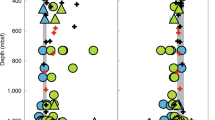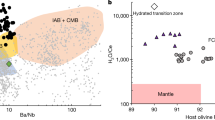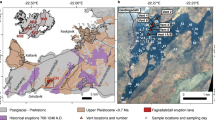Abstract
Partial melting of Earth’s mantle generates oceanic crust and leaves behind a chemically depleted residual mantle. The time-integrated composition of this chemically depleted mantle is generally inferred from basalts produced at mid-ocean ridges. However, isotopic differences between oceanic mantle rocks and mid-ocean ridge basalts suggest that mantle and basalt composition could differ. Here we measure neodymium isotope ratios in olivine-hosted melt inclusions from lavas of the Azores mantle plume. We find neodymium isotope ratios that include the highest values measured in basalts, and suggest that melts from ultra-depleted mantle contribute to the isotopic diversity of the erupted lavas. Ultra-depleted melts have exceedingly low preservation potential during magma extraction and evolution due to progressive mixing with melts that are enriched in incompatible elements. A notable contribution of ultra-depleted melts to the Azores mantle plume therefore implies that variably depleted mantle is the volumetrically dominant component of the Azores plume. We argue that variably depleted mantle, sometimes ranging to ultra-depleted compositions, may be a ubiquitous part of most ocean island and mid-ocean ridge basalt sources. If so, Earth’s mantle may be more depleted than previously thought, which has important implications for the rate of mass exchange between crust and mantle, plume dynamics and compositional stratification of Earth’s mantle.
This is a preview of subscription content, access via your institution
Access options
Access Nature and 54 other Nature Portfolio journals
Get Nature+, our best-value online-access subscription
$29.99 / 30 days
cancel any time
Subscribe to this journal
Receive 12 print issues and online access
$259.00 per year
only $21.58 per issue
Buy this article
- Purchase on Springer Link
- Instant access to full article PDF
Prices may be subject to local taxes which are calculated during checkout



Similar content being viewed by others
Data availability
The authors declare that the data supporting the findings of this study are available within the article and the Supplementary information.
References
Hofmann, A. W. Chemical differentiation of the Earth—the relationship between mantle, continental-crust, and oceanic-crust. Earth Planet Sci. Lett. 90, 297–314 (1988).
Gast, P. W., Tilton, G. R. & Hedge, C. Isotopic composition of lead and strontium from Ascension and Gough Islands. Science 145, 1181–1185 (1964).
Allègre, C. J., Staudacher, T. & Sarda, P. Rare gas systematics: formation of the atmosphere, evolution and structure of the Earth’s mantle. Earth Planet Sci. Lett. 81, 127–150 (1987).
Caro, G., Bourdon, B., Birck, J.-L. & Moorbath, S. High-precision 142Nd/144Nd measurements in terrestrial rocks: constraints on the early differentiation of the Earth’s mantle. Geochim. Cosmochim. Acta 70, 164–191 (2006).
Bennett, V. C., Brandon, A. D. & Nutman, A. P. Coupled 142Nd-143Nd isotopic evidence for Hadean mantle dynamics. Science 318, 1907–1910 (2007).
Stracke, A. in Encyclopedia of Marine Geosciences (eds Harff, J. et al.) 182–185 (Springer Netherlands, 2016).
Langmuir, C. H., Klein, E. M. & Plank, T. in Mantle Flow and Melt Generation at Mid-Ocean Ridges (eds Morgan, J. P. et al.) 183–210 (AGU, 1992).
Willbold, M. & Stracke, A. Trace element composition of mantle end-members: implications for recycling of oceanic and upper and lower continental crust. Geochem. Geophys. Geosys. 7, Q04004 (2006).
Zindler, A. & Hart, S. Chemical geodynamics. Annu. Rev. Earth Planet Sci. 14, 493–571 (1986).
Stracke, A. Earth’s heterogeneous mantle: a product of convection-driven interaction between crust and mantle. Chem. Geol. 330–331, 274–299 (2012).
Stracke, A. in Encyclopedia of Geochemistry: A Comprehensive Reference Source on the Chemistry of the Earth (ed. White, W. M.) 867–878 (Springer International Publishing, 2018).
Tackley, P. J. in Treatise on Geophysics (ed. Schubert, G.) 521–585 (Elsevier, 2015).
Stracke, A. & Bourdon, B. The importance of melt extraction for tracing mantle heterogeneity. Geochim. Cosmochim. Acta 73, 218–238 (2009).
Stracke, A. et al. Abyssal peridotite Hf isotopes identify extreme mantle depletion. Earth Planet Sci. Lett. 308, 359–368 (2011).
Rudge, J. F., Maclennan, J. & Stracke, A. The geochemical consequences of mixing melts from a heterogeneous mantle. Geochim. Cosmochim. Acta 114, 112–143 (2013).
Cipriani, A., Brueckner, H. K., Bonatti, E. & Brunelli, D. Oceanic crust generated by elusive parents: Sr and Nd isotopes in basalt-peridotite pairs from the Mid-Atlantic ridge. Geology 32, 657–660 (2004).
Salters, V. J. M. & Dick, H. J. B. Mineralogy of the mid-ocean-ridge basalt source from neodymium isotopic composition of abyssal peridotites. Nature 418, 68–72 (2002).
Salters, V. J. M., Mallick, S., Hart, S. R., Langmuir, C. H. & Stracke, A. Domains of depleted mantle; new evidence from hafnium and neodymium isotopes. Geochem. Geophys. Geosys. 12, Q10017 (2011).
Sanfilippo, A., Salters, V., Tribuzio, R. & Zanetti, A. Role of ancient, ultra-depleted mantle in mid-ocean-ridge magmatism. Earth Planet Sci. Lett. 511, 89–98 (2019).
Liu, C.-Z., Snow, J. E., Brügmann, G., Hellebrand, E. & Hofmann, A. W. Non-chondritic HSE budget in Earth’s upper mantle evidenced by abyssal peridotites from Gakkel ridge (Arctic Ocean). Earth Planet Sci. Lett. 283, 122–132 (2009).
Byerly, B. L. & Lassiter, J. C. Isotopically ultradepleted domains in the convecting upper mantle: implications for MORB petrogenesis. Geology 42, 203–206 (2014).
Sobolev, A. V. & Shimizu, N. Ultra-depleted primary melt included in an olivine from the Mid-Atlantic ridge. Nature 363, 151–154 (1993).
Sobolev, A. V., Hofmann, A. W., Jochum, K. P., Kuzmin, D. V. & Stoll, B. A young source for the Hawaiian plume. Nature 476, 434–437 (2011).
Saal, A. E. et al. Pb isotopic variability in melt inclusions from the EMI-EMII-HIMU mantle end-members and the role of the oceanic lithosphere. Earth Planet Sci. Lett. 240, 605–620 (2005).
Reinhard, A. A. et al. Sr and Nd isotopic compositions of individual olivine-hosted melt inclusions from Hawai’i and Samoa: implications for the origin of isotopic heterogeneity in melt inclusions from OIB lavas. Chem. Geol. 495, 36–49 (2018).
Koornneef, J. M. et al. TIMS analysis of Sr and Nd isotopes in melt inclusions from Italian potassium-rich lavas using prototype 1013Ω amplifiers. Chem. Geol. 397, 14–23 (2015).
Beier, C., Stracke, A. & Haase, K. M. The peculiar geochemical signatures of Sao Miguel (Azores) lavas: metasomatised or recycled mantle sources? Earth Planet Sci. Lett. 259, 186–199 (2007).
Elliott, T., Blichert-Toft, J., Heumann, A., Koetsier, G. & Forjaz, V. The origin of enriched mantle beneath Sao Miguel, Azores. Geochim. Cosmochim. Acta 71, 219–240 (2007).
Salters, V. J. M. & Zindler, A. Extreme Hf-176 Hf-177 in the sub-oceanic mantle. Earth Planet Sci. Lett. 129, 13–30 (1995).
Bizimis, M., Griselin, M., Lassiter, J. C., Salters, V. J. M. & Sen, G. Ancient recycled mantle lithosphere in the Hawaiian plume: osmium-hafnium isotope evidence from peridotite mantle xenoliths. Earth Planet Sci. Lett. 257, 259–273 (2007).
DeFelice, C., Mallick, S., Saal, A. E. & Huang, S. An isotopically depleted lower mantle component is intrinsic to the Hawaiian mantle plume. Nat. Geosci. 12, 487–492 (2019).
Kumari, S., Paul, D. & Stracke, A. Open system models of isotopic evolution in Earth’s silicate reservoirs: implications for crustal growth and mantle heterogeneity. Geochim. Cosmochim. Acta 195, 142–157 (2016).
French, S. W. & Romanowicz, B. Broad plumes rooted at the base of the Earth’s mantle beneath major hotspots. Nature 525, 95–99 (2015).
Saki, M., Thomas, C., Nippress, S. E. J. & Lessing, S. Topography of upper mantle seismic discontinuities beneath the North Atlantic: the Azores, Canary and Cape Verde plumes. Earth Planet Sci. Lett. 409, 193–202 (2015).
O’Neill, C. & Sigloch, K. in Volcanoes of the Azores: Revealing the Geological Secrets of the Central Northern Atlantic Islands (eds Kueppers, U. & Beier, C.) 71–87 (Springer Berlin Heidelberg, 2018).
Montelli, R., Nolet, G., Dahlen, F. A. & Mastres, G. A catalogue of deep mantle plumes: new results from finite-frequency tomography. Geochem. Geophys. Geosys. 7, Q11007 (2006).
Montelli, R. et al. Finite-frequency tomography reveals a variety of plumes in the mantle. Science 303, 338–343 (2004).
Maguire, R., Ritsema, J. & Goes, S. Signals of 660 km topography and harzburgite enrichment in seismic images of whole-mantle upwellings. Geophys. Res. Lett. 44, 3600–3607 (2017).
Wolfe, C. J. et al. Mantle shear-wave velocity structure beneath the Hawaiian hot spot. Science 326, 1388–1390 (2009).
Huang, J. & Davies, G. F. Geochemical processing in a three-dimensional regional spherical shell model of mantle convection. Geochem. Geophys. Geosys. 8, Q11006 (2007).
Schutt, D. L. & Lesher, C. E. Effects of melt depletion on the density and seismic velocity of garnet and spinel lherzolite. J. Geophys. Res.: Solid Earth 111, B05401 (2006).
Nakagawa, T., Tackley, P. J., Deschamps, F. & Connolly, J. A. D. The influence of MORB and harzburgite composition on thermo-chemical mantle convection in a 3-D spherical shell with self-consistently calculated mineral physics. Earth Planet Sci. Lett. 296, 403–412 (2010).
Ishii, T., Kojitani, H. & Akaogi, M. Phase relations of harzburgite and MORB up to the uppermost lower mantle conditions: precise comparison with pyrolite by multisample cell high-pressure experiments with implication to dynamics of subducted slabs. J. Geophys. Res. Solid Earth 124, 3491–3507 (2019).
Irifune, T. & Ringwood, A. E. Phase transformations in subducted oceanic crust and buoyancy relationships at depths of 600–800 km in the mantle. Earth Planet Sci. Lett. 117, 101–110 (1993).
Asimow, P. D. & Langmuir, C. H. The importance of water to oceanic mantle melting regimes. Nature 421, 815–820 (2003).
Herzberg, C. & Asimow, P. D. Petrology of some oceanic island basalts: PRIMELTS2.XLS software for primary magma calculation. Geochem. Geophys. Geosys. 9, Q09001 (2008).
Beier, C., Haase, K. M. & Turner, S. P. Conditions of melting beneath the Azores. Lithos 144–145, 1–11 (2012).
Ribe, N. M. The dynamics of plume ridge interaction, 2: off-ridge plumes. J. Geophys. Res. 101, 19,195–116,204 (1996).
Brandenburg, J. P. & van Keken, P. E. Deep storage of oceanic crust in a vigorously convecting mantle. J. Geophys. Res. Solid Earth 112, B06403 (2007).
Mallick, S., Dick, H. J. B., Sachi-Kocher, A. & Salters, V. J. M. Isotope and trace element insights into heterogeneity of subridge mantle. Geochem. Geophys. Geosys. 15, 2438–2453 (2014).
Snow, J. E., Hart, S. R. & Dick, H. J. B. Nd and Sr isotope evidence linking mid-ocean-ridge basalts and abyssal peridotites. Nature 371, 57–60 (1994).
Warren, J. M., Shimizu, N., Sakaguchi, C., Dick, H. J. B. & Nakamura, E. An assessment of upper mantle heterogeneity based on abyssal peridotite isotopic compositions. J. Geophys. Res. 114, B12203 (2009).
Mallick, S., Standish, J. J. & Bizimis, M. Constraints on the mantle mineralogy of an ultra-slow ridge: hafnium isotopes in abyssal peridotites and basalts from the 9–25°E Southwest Indian ridge. Earth Planet Sci. Lett. 410, 42–53 (2015).
Brunelli, D., Cipriani, A. & Bonatti, E. Thermal effects of pyroxenites on mantle melting below mid-ocean ridges. Nat. Geosci. 11, 520–525 (2018).
Genske, F. S. et al. Comparing the nature of the western and eastern Azores mantle. Geochim. Cosmochim. Acta 172, 76–92 (2016).
McDonough, W. F. & Sun, S.-s. The composition of the Earth. Chem. Geol. 120, 223–253 (1995).
Jarosewich, E., Nelen, J. A. & Norberg, J. A. Reference samples for electron microprobe analysis. Geostand. Newsl. 4, 43–47 (1980).
Van Achterberg, E., Ryan, C., Jackson, S. & Griffin, W. in Appendix 3: LASER-Ablation-ICPMS in the Earth Sciences, Vol. 29 (ed Sylvester, P.) 239–243 (Mineralogical Association of Canada, 2001).
Griffin, W. L., Powell, W. J., Pearson, N. J. & O’Reilly, S. Y. in Laser Ablation–ICP–MS in the Earth Sciences: Current Practices and Outstanding Issues, Vol. 40 (ed Sylvester, P.) 307–311 (Mineralogical Association of Canada, 2008).
Jochum, K. P. et al. GeoReM: a new geochemical database for reference materials and isotopic standards. Geostand. Geoanal. Res. 29, 333–338 (2005).
Hart, S. R. & Brooks, C. The geochemistry and evolution of the early Precambrian mantle. Contrib. Miner. Pet. 61, 109–128 (1977).
Pin, C. & Zalduegui, J. F. S. Sequential separation of light rare-earth elements, thorium and uranium by miniaturized extraction chromatography: application to isotopic analyses of silicate rocks. Anal. Chim. Acta 339, 79–89 (1997).
Koornneef, J. M., Bouman, C., Schwieters, J. B. & Davies, G. R. Measurement of small ion beams by thermal ionisation mass spectrometry using new 1013Ohm resistors. Anal. Chim. Acta 819, 49–55 (2014).
Acknowledgements
This work was supported by the German Research Foundation (grant no. GE2817/6-1). F.G. acknowledges support from Europlanet 2020 RI, which has received funding from the European Union’s Horizon 2020 research and innovation programme under grant agreement no. 65420. J.M.K. received funding from the European Research Council (ERC) under the European Union’s Horizon 2020 research and innovation programme under grant agreement no. 759563. C. Beier is thanked for contributing samples from Pico Island.
Author information
Authors and Affiliations
Contributions
A.S. and F.G. conceived and designed the study. A.S., F.G. and J.M.K. wrote the manuscript and contributed to data interpretation. F.G. and J.B. conducted the electron microprobe and LA-ICPMS analyses. F.G. and A.S. conducted the MC-ICPMS analyses. F.G. and J.M.K. conducted the TIMS analyses.
Corresponding author
Ethics declarations
Competing interests
The authors declare no competing interests.
Additional information
Publisher’s note: Springer Nature remains neutral with regard to jurisdictional claims in published maps and institutional affiliations.
Supplementary information
Supplementary dataset Tables 1 and 2.
REE and Nd isotope data.
Rights and permissions
About this article
Cite this article
Stracke, A., Genske, F., Berndt, J. et al. Ubiquitous ultra-depleted domains in Earth’s mantle. Nat. Geosci. 12, 851–855 (2019). https://doi.org/10.1038/s41561-019-0446-z
Received:
Accepted:
Published:
Issue Date:
DOI: https://doi.org/10.1038/s41561-019-0446-z
This article is cited by
-
Earth’s mantle composition revealed by mantle plumes
Nature Reviews Earth & Environment (2023)
-
What can we learn from REE abundances in clinopyroxene and orthopyroxene in residual mantle peridotites?
Contributions to Mineralogy and Petrology (2021)
-
Recycled arc mantle recovered from the Mid-Atlantic Ridge
Nature Communications (2020)



